tires CHEVROLET MONTE CARLO 1976 2.G Owners Manual
[x] Cancel search | Manufacturer: CHEVROLET, Model Year: 1976, Model line: MONTE CARLO, Model: CHEVROLET MONTE CARLO 1976 2.GPages: 102, PDF Size: 23.79 MB
Page 3 of 102
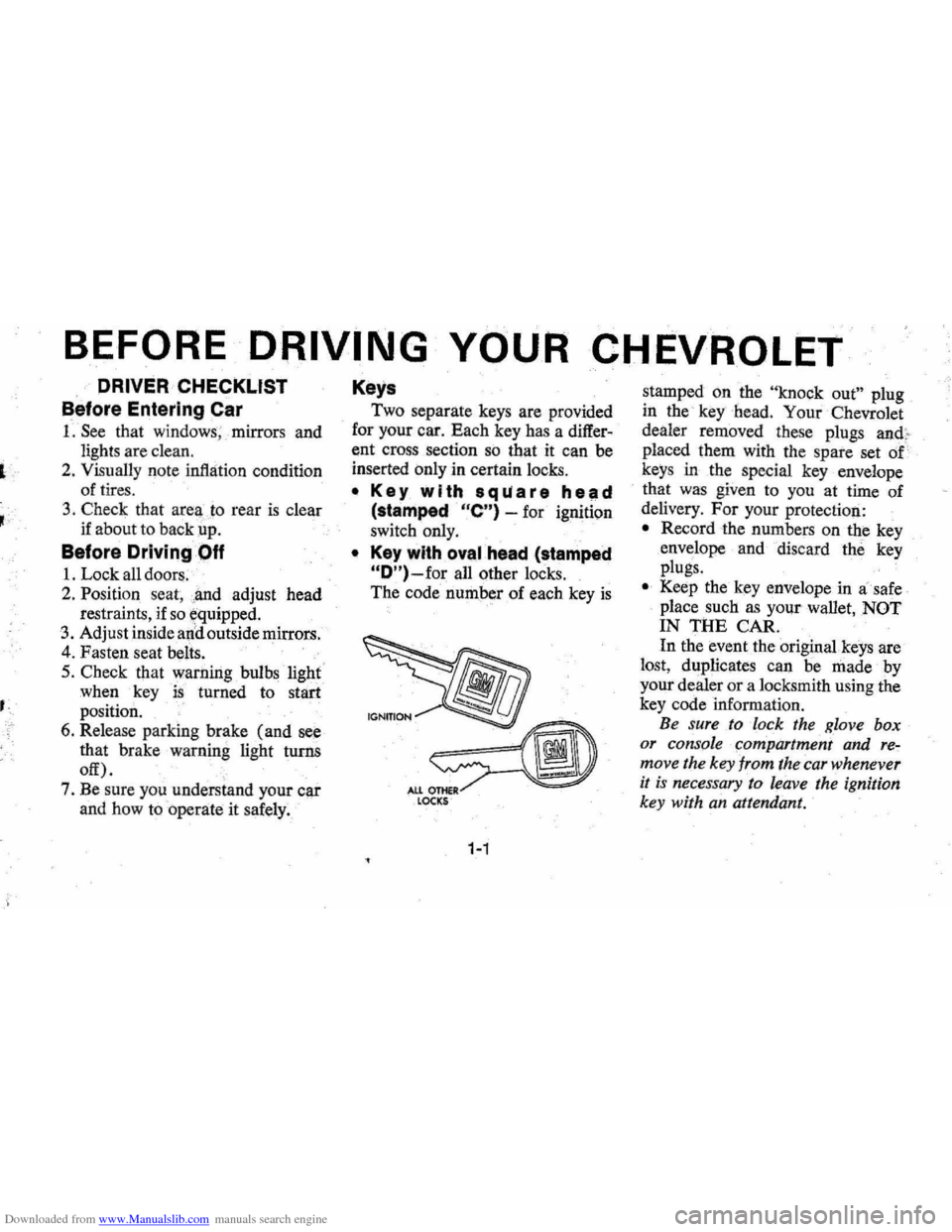
Downloaded from www.Manualslib.com manuals search engine ,
BEFORE DRIVING YOUR CHEVROLET
DRIVER CHECKLIST
Before Entering Car
1. See that windows ; mirrors and
lights are clean.
2. Visually note inJIation condition
of tires.
3. Check that area to rear is clear
if about to back up.
Before Driving Off
1. Lock all doors.
2. Position seat, jmd adjust head
restraints, if
so ¢quipped.
3. Adjus!insidean'd outside mirrors.
4. Fasten seat belts.
5. Check that warning bulbs light
when key
is turned to start
position. .
6. Release parking brake ( and see
that brake warning light turns
off). ,
7. Be sure you understand your car
and how
to 'operate it safely.
Keys
Two separate keys are provided
for your car. Each key has a
differ
ent cross section so that it can be
inserted only in certain locks.
• Key with s qua r e hell d
(stamped "e") -for ignition
switch only.
• Key with oval head (stamped
"O")-for all other locks.
,
The code number of each key is
All OTHeR LOCKS
1-1
stamped on the "knock out" plug
in the '
key-bead. Your Chevrolet
dealer removed these plugs
and,.
placed them with the spare set of
keys in the special key envelope
. that was given to you at time of
delivery.
For your protection:
• Record the numbers on the key
envdope and discard the key
plugs.
• Keep the key envelope in a safe
place such
as YOII! wallet, NOT
IN THE CAR.
In the event
the original keys are
lost,
dl!plicates can be made by
your dealer or a locksmith using the
key code information.
Be sure to lock the Klove box
or console
90mpartment and re~
move the key from the car whenever
it is necessary to leave the ignition
key with
an attendant.
Page 8 of 102
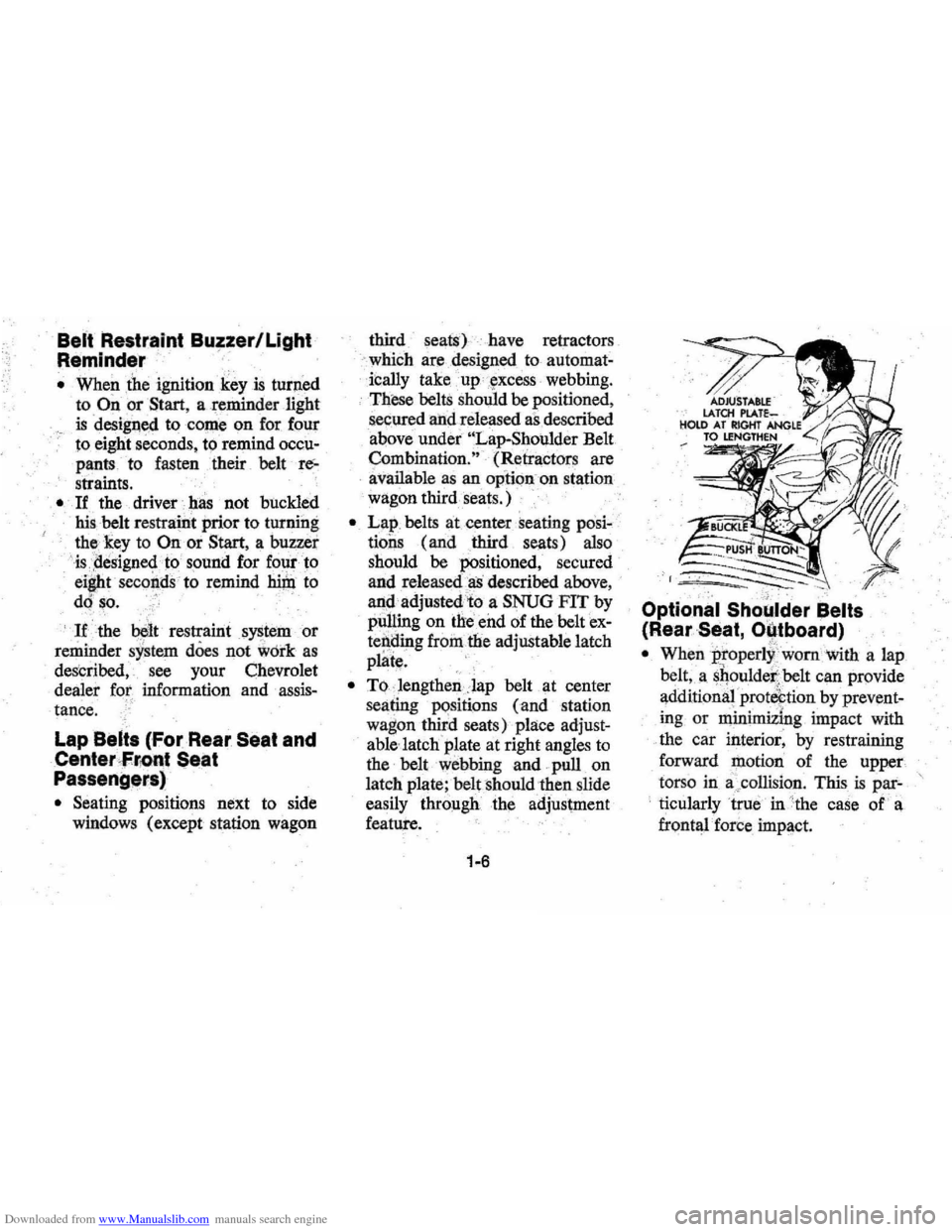
Downloaded from www.Manualslib.com manuals search engine Beit Restraint Bu~zer/Light
Reminder
• When .the ignition key is turp.ed
to On or Start, a ,reminder light
is desigl1ed to come on for four
to eight seconds,
to remind occu
pants to fasten their belt re'
straints.
• If the driver hils not buckled
his belt restraint prior to turning
th~key to On or Start, a buzzer
is . ,designed to sound for four to
, dei~t seco'Yds to remind h.i!I!' to
9 so. ".
If ,the belt restraint system or
reminder system
dOes not work as
described,
see your Chevrolet
dealer for information and
assis
tance.
Lap Belts (For Rear Seat and
Center ·,Fr,on1 Seal
Passengers)
• Seating positions next to side
windows (except station wagon third
seats)
' have retractors
'which ar!) designed to automat
ically take.up¢xcess webbing.
, TIrese beltS should be positioned,
secured
ahd released as described
above undei
"Lap-Shoulder Belt
Combination." (Retractors are
, available as an option on station
wa.gon third seats. ) ,
•
Lap belts at center seating posi
tions
( and third seats) also
should be positioned, secured
and
releaseda.s described above, '
arjd adjusted'fo a SNUG FIT by
pulling on the end of the belt ex
teiiaing froin the adjustable latch
plai~. '
• To .;lengthen.Jap
belt at center
seating
positions (and station
wagonthitd seats) place adjust
able ,latch 'plate
at right angles to
the belt webbing and pull on
latch plate; belt
should then slide
easily thro)lgh the adjus\ment
featute.
r'~
Optional Sho~lder ~elts
(Rear Seat, Outboard)
• Whenptoperlil>vorn with a lap
belt,a shoulde~;belt can provide
l\dditiona.! protej;tion by prevent
ing or minimizing impact with
the car interior;
by restraining
forward rnotion of the upper
torso in a ,collision. This
is par~ ,
ticularlytrue in 'the case of a
frontalforce impact.
Page 12 of 102
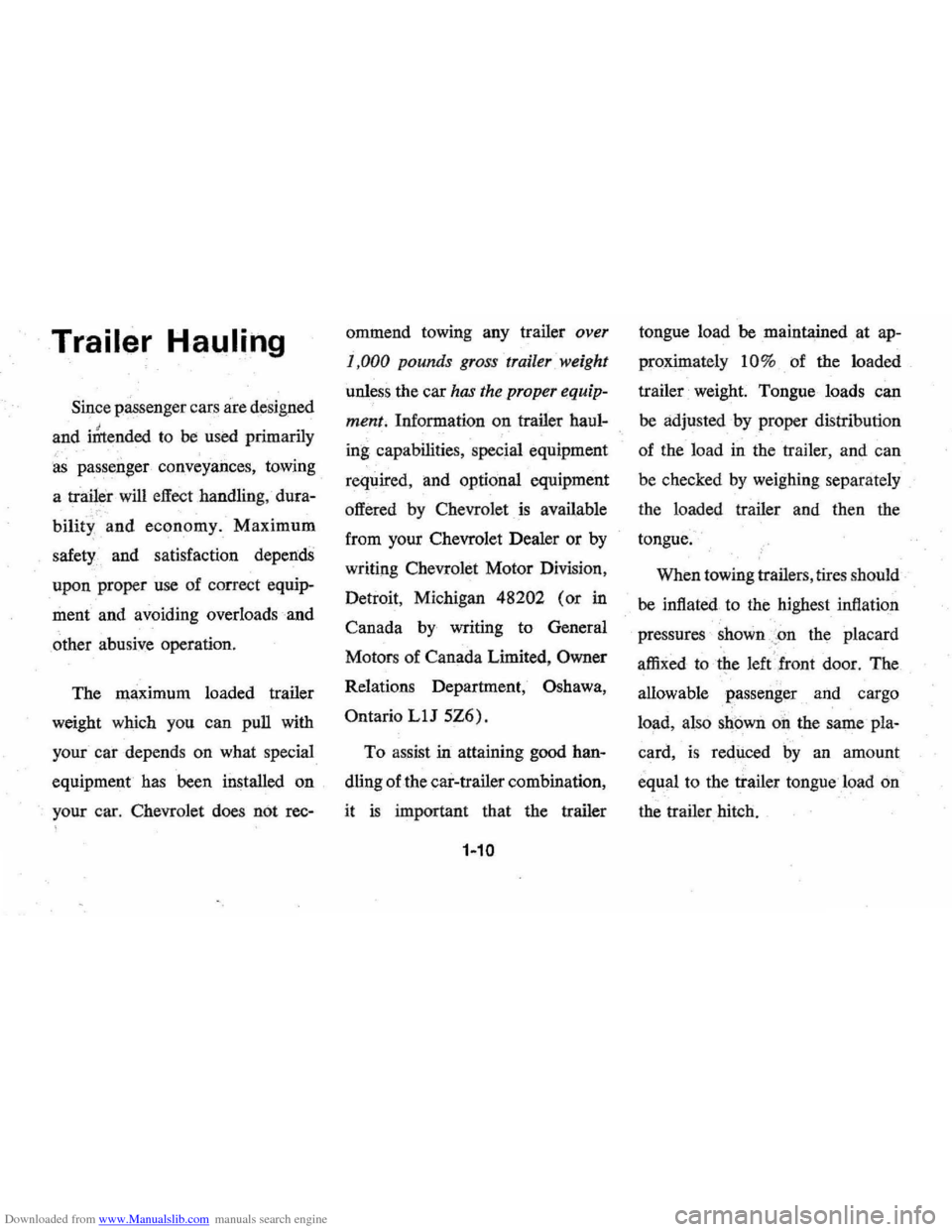
Downloaded from www.Manualslib.com manuals search engine Trailer Halllihg
Since passenger cars are designed
and
i~ended to be used primarily
as passenger conveyances, towing
a
trailer will effect handling , dura-
" bility and economy. Maximum
safety and satisfaction depends
upon proper use of correct equip
ment and avoiding overloads and
other abusive operation.
The maximum loaded trailer
weight which you can pull with
your car depends on what special
equipment has been installed
on
your car. Chevrolet does not rec-ommend
towing any trailer
over
1,000 pounds gross trailer weight
unless the car has the proper (!quip
ment .
Information on trailer haul
ing capabilities, special equipment
required , and optional equipment
offered by Chevrolet
is available
from your Chevrolet Dealer or by
writing Chevrolet Motor Division,
Detroit, Michigan
48202 (or in
Canada by writing to General
Motors of Canada Limited,
Owner
Relations Department, Oshawa,
Ontario LlJ 5Z6).
To assist in attaining good han
dling of the car-trailer combination,
it is important that the trailer
1-10
tongue load be maintained at ap
proximately
10% of the loaded
trailer weight. Tongue loads can
be adjusted by proper distribution
of the load in the trailer, and can
be checked
by weighing separately
the loaded trailer and then the
tongue.
When towing trailers, tires should
be inflated to the highest inflation
pressures
shown :on the placard
affixed to
the left' front door. The
allowable passenger and cargo
load , also shown
on the same pla
card,
is reduced by an amount
eq ual to the trailer tongue load on
the trailer hitch.
Page 58 of 102
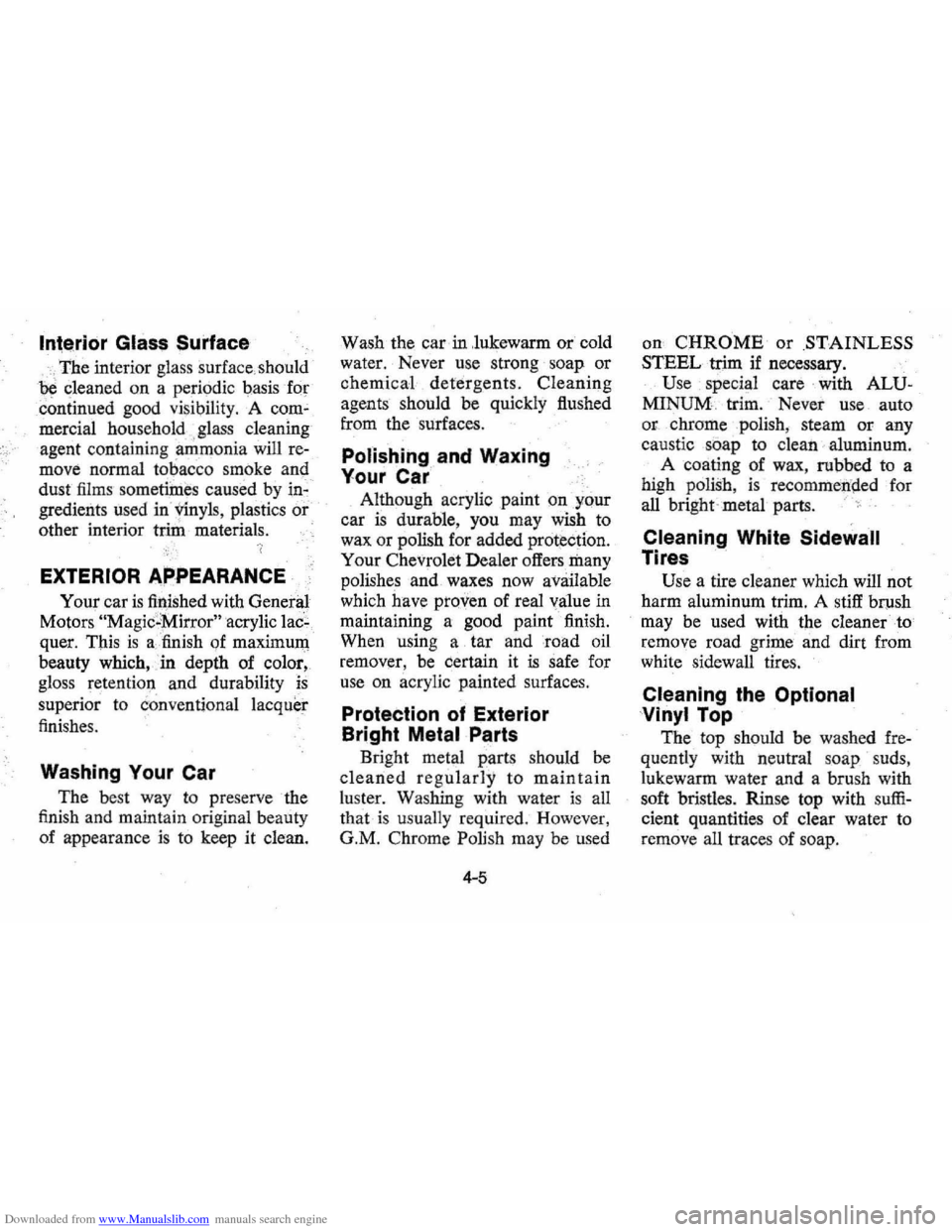
Downloaded from www.Manualslib.com manuals search engine IntE)rior Glass Surface
.. The interior glass surface . should
j;)e cleaned on a periodic basis for
continued good
visil;Jility. A com
mercial household . glass cleaning
agent containing ammonia
will re
move normal tobacco smoke and
dust
films sometimes caused by inc
gredients used in' vinyls , plastics or
other interior trim materials.
EXTERIOR APPEARANCE
Your car is finished with General
Motors "Magic";Mirror" acrylic lac'
quer. Tllis is a .· finish qf maximull)
beauty which,.in depth of color,
gloss retention and durability is
superior to conventiona l lacquer
finishes.
Washing Your Car
The best way to pres erve the
finish and maintain original beauty
of appearance
is to keep it clean. Wash
the car in lukewarm or cold
water . Never use stro
ng soap or
chemical detergents. Cleaning
agents should be quickl y flushed
from the surfaces .
Polishing and Waxing
Your Car
Although acrylic paint on your
car
is durable , you may wish to
wax or polish for added protection.
Your Chevrolet Dealer offers many
polishes and waxes now available
which have
proven of real value in
maintaining a good paint
finish.
When using a tar and road oil
remover, be certain it is safe for
use on acrylic painted surfaces.
Protection of Exterior
Bright
Metal Parts
Bright metal parts should he
cleaned regularly to maintain
luster. Washing with water is all
th at is usually required. However,
G.M. Chro
me Polish may be used
4-5
on CHROME or .STAINLESS
STEEL trim if necessary.
Use special care with ALU
MINUM . tr im . Never use auto
or chrome .polish , steam or any
caustic soap
to clean aluminum.
A coating of wax, rubbed to a
high polish,
is recommenlled for
all
bright · metal parts. .. ..
CIE)aning White Sidewall
TirE)s
Use a tire clea ner which will not
harm aluminum trim. A stiff brush
may be used with tile cleaner to
remove road grime and dirt from
white sidewall tires.
Cleaning thE) Optional
Vinyl
Top
The top should be washed fre
quently with neutral soap suds,
lukewarm water and a brush with
soft bristles. Rinse top with
suffi
cient quantities of clear water to
remove all traces of soap.
Page 60 of 102
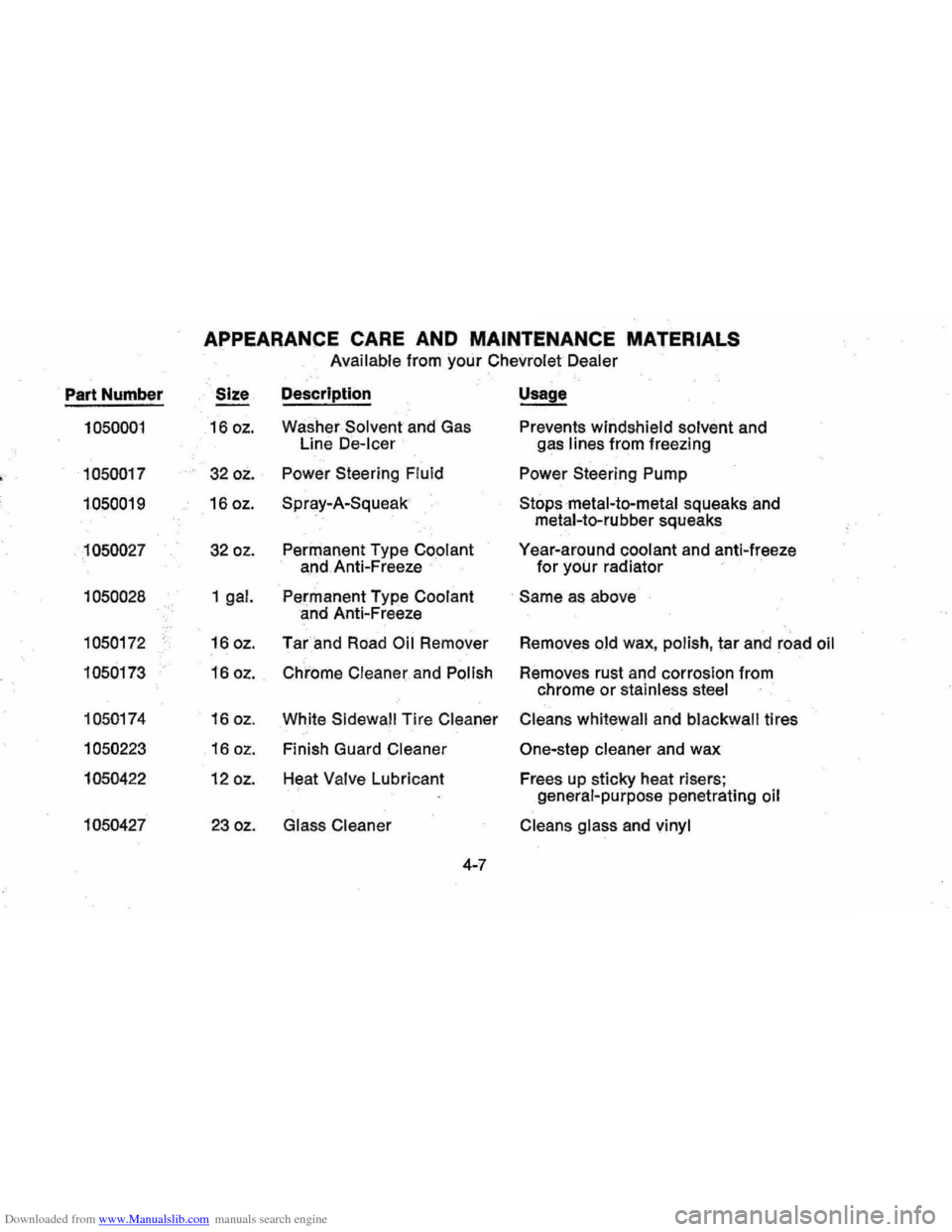
Downloaded from www.Manualslib.com manuals search engine APPEARANCE CARE AND MAINTENANCE MATERIALS
Available from your Chevrolet Dealer
Part Number Size
Description Usage
1050001 16 oz. Washer Solvent and Gas Prevents windshield solvent and
Line
De-Icer gas lines from freezing
, 1050017 32 oz. Power
Steering Fluid Power Steering Pump
1050019 16 oz. Spray-A-Squeak
Stopsmetal-to-metal squeaks .and
metal-ta-rubber squeaks
1050027 32 oz. Permanent Type Coolant Year-around coolant and anti-freeze
and . Anti-Freeze for your radiator
1050028 1 gal. Permanent Type Coolant . Same as above
and Anti-Freeze
1050172 16 oz. Tar and Road Oil Remover Removes old wax, polish , tar and road oil
1050173 16 oz. Chrome Cleaner and Polish Removes rust and corrosion from
chrome
or stainless steel
1050174 16 oz
.
White Sidewall Tire Cleaner Cleans whitewall and blackwall tires
1050223 16 oz. Finish Guard Cleaner One-step cleaner and wax
1050422 12 oz. Heat Valve Lubricant
Frees up sticky heat risers ;
genera l-purpose penetrating oil
1050427 23 oz. Glass Cleaner Cleans glass and vinyl
4-7
Page 75 of 102
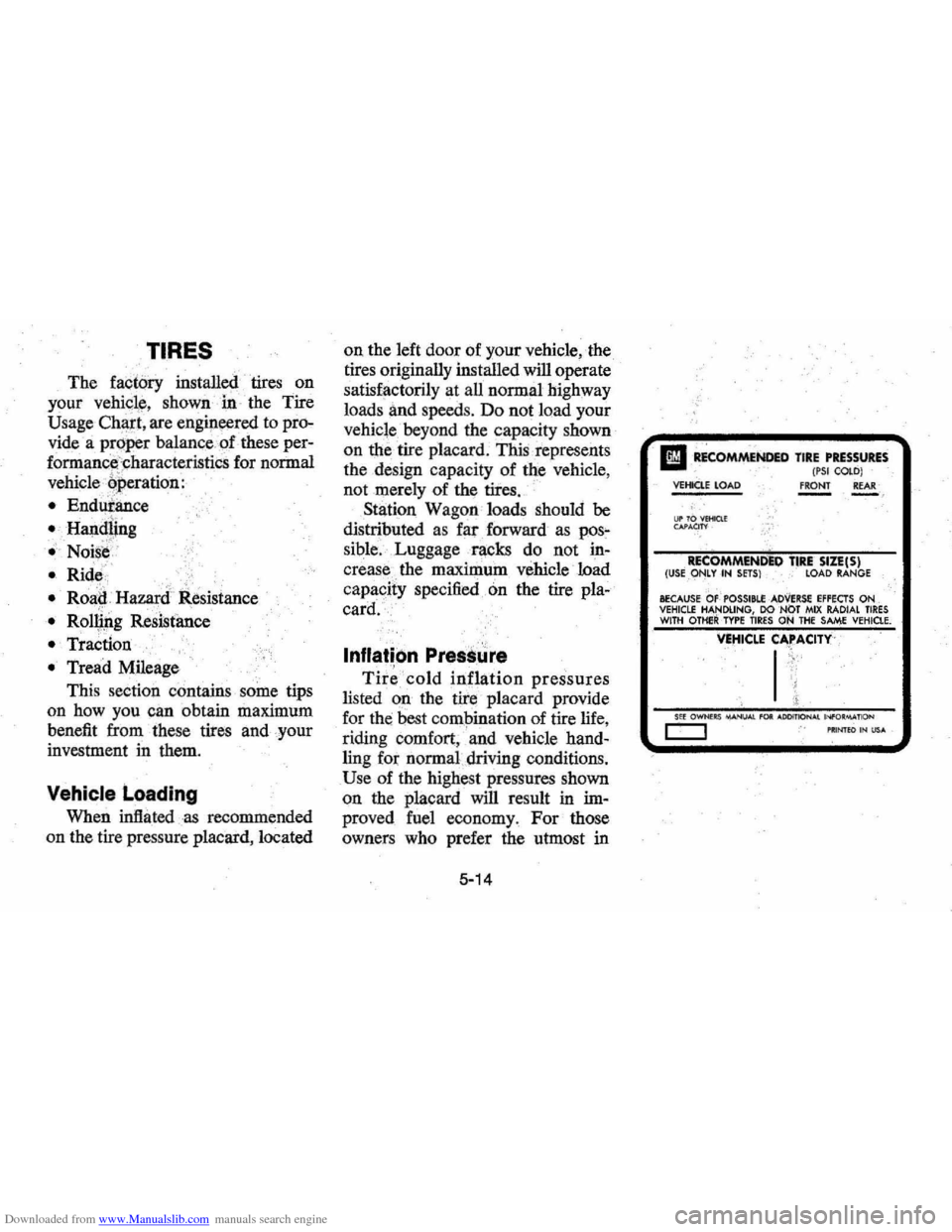
Downloaded from www.Manualslib.com manuals search engine TIRES
The factory installed tires on
your
vehicl ,e , shown in · the Tire
Usage Ch
per
formance'characteristics
for normal
vehicle
~peration:
• Endu tiLnce '.~"
• Handling . ,'c'
• Noise·'
• Ride; .. /.
• Roaa Hazard ~esistance
• Rol~!1g Re~l$tiLnce
• Traction .'. .. ,
• Tread
Mileage .
This section contains some tips
on
how you can obtain maximum
benefit from these tires and your
investment in them.
Vehicle Loading
When inftiltedas recommended
on the tire pressure placard, located on
the left door
of your vehicle , the
tires originally installed will operate
satisfactorily at all normal highway
loads
and s peeds. Do not load your
vehicle beyond the capacity shown
on the tire placard . This represents
the design capacity of the vehicle ,
not merely of the tires .
Station Wagon loads
Should be
distributed as far forward as pos~
sihle . .Luggage racks do not in
crease
the maximum vehicle load
capaciiy specified. on the tire
pla
card.
Inflation Presslire
Tir~' cold inflation pressures
listed ' on the tire placard provide
for
the best combination of tire life,
riding ' comfort , . and vehicle
hand
ling for normal . driving conditions .
Use of the highest pressures shown
on the placard will result
in im
proved fuel economy. For those
owners
who prefer the utmost in
5-14
I
II REcOMMENDED TIRE PRESSURES - (PSI COlO) : YeHKlE LOAD fRONT REAR - ,
ur TO V1:HICI.! ~"m ;,..'
RECOMMENbiO TIRE SIZE(S) (USEQNLY IN SETS) LOAD RANGE .
BECAUSE, :O':'POSSI8LE ·A ,DYERSE EFFECTS ON VEHICLE HANDLING, DO 'NC)T MIX RADIAL TIRES WITH OTHER' TYPE TIRES oN THE SAME VEHICLE.
IIE!iICLE C"'~ACITY ~~,' ; ,',
j
, ~ SU OWNUS ~\) ..... fOft "'DOIflONAl l.'IfOR"'-"TION
c:::J I'I!INTEO IN USA _
Page 76 of 102
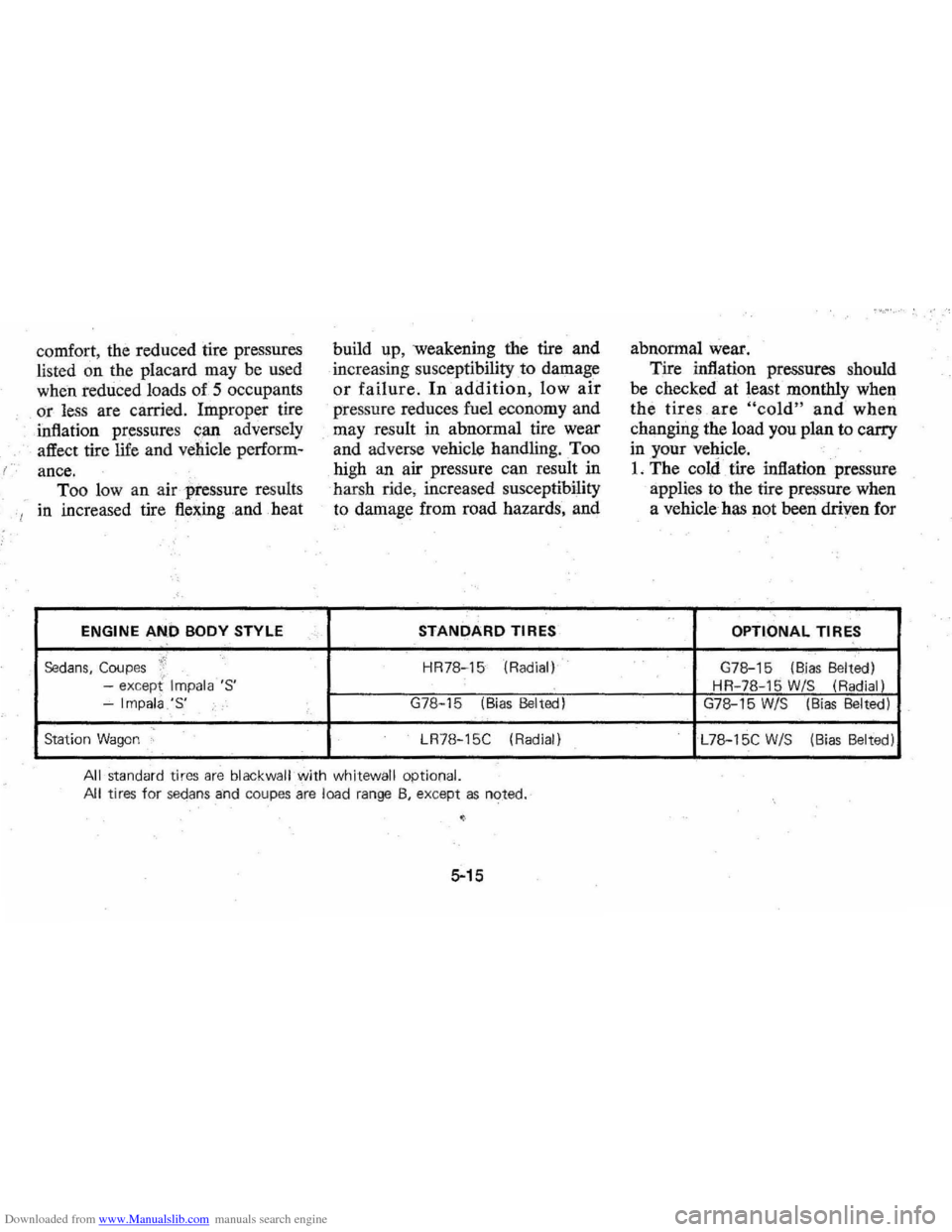
Downloaded from www.Manualslib.com manuals search engine co mfort, the reduced tire pressures
listed on the placard may
be used
when reduced loads of 5 occupants
or
less are carried. Improper tire
inflation pressures
c,an adversely
affect tire life and vehicle perform-
l' ance.
Too Iowan air 'pressure results
I in increased tire flellingand heat
ENGINE AN,D BODY STYLE
4' Sedans, Coupe s ;;' " -except Imp ala 'S '
~ Impala ,'S' ,
Station Wagon
,
.',
build up, weakening the tire and
increasing
sus ceptibility to damage
or failure. In addition, low air
pre ssure reduces fuel economy and
may result in abnormal tire wear
and adverse vehicle handling. Too
high an air pressure can re sult
in
har sh ride , increas ,ed su sceptibility
to dam a
ge fr om road hazards, and
STANDARD TIRES
HR78-15 (R adial)
G78-1 5 (Bias Belted)
LR7
8-1 5C (Radial)
All
sta ndard tires are blackwall With whi tewall optional.
All tires fo r sedan s a-nd co upes are load range 8, except as n ote d.
5-15
abnormal wear.
Tire inflation pressures should
be checked at least monthly when
the
tires , are "cold" and when
changing the load you plan
to carry
in your vehicle .
L The cold tire inflation pressure
applies
to the tire pressure when
a vehicle has not been driven for
OPTIONAL TIRES
G78-15 (Bias Belted)
HR-78-1 5
W/S (Ra dial)
G
78-15 W/S (Bias Belted)
L78-1 5C W/S (Bias Belted)
Page 77 of 102
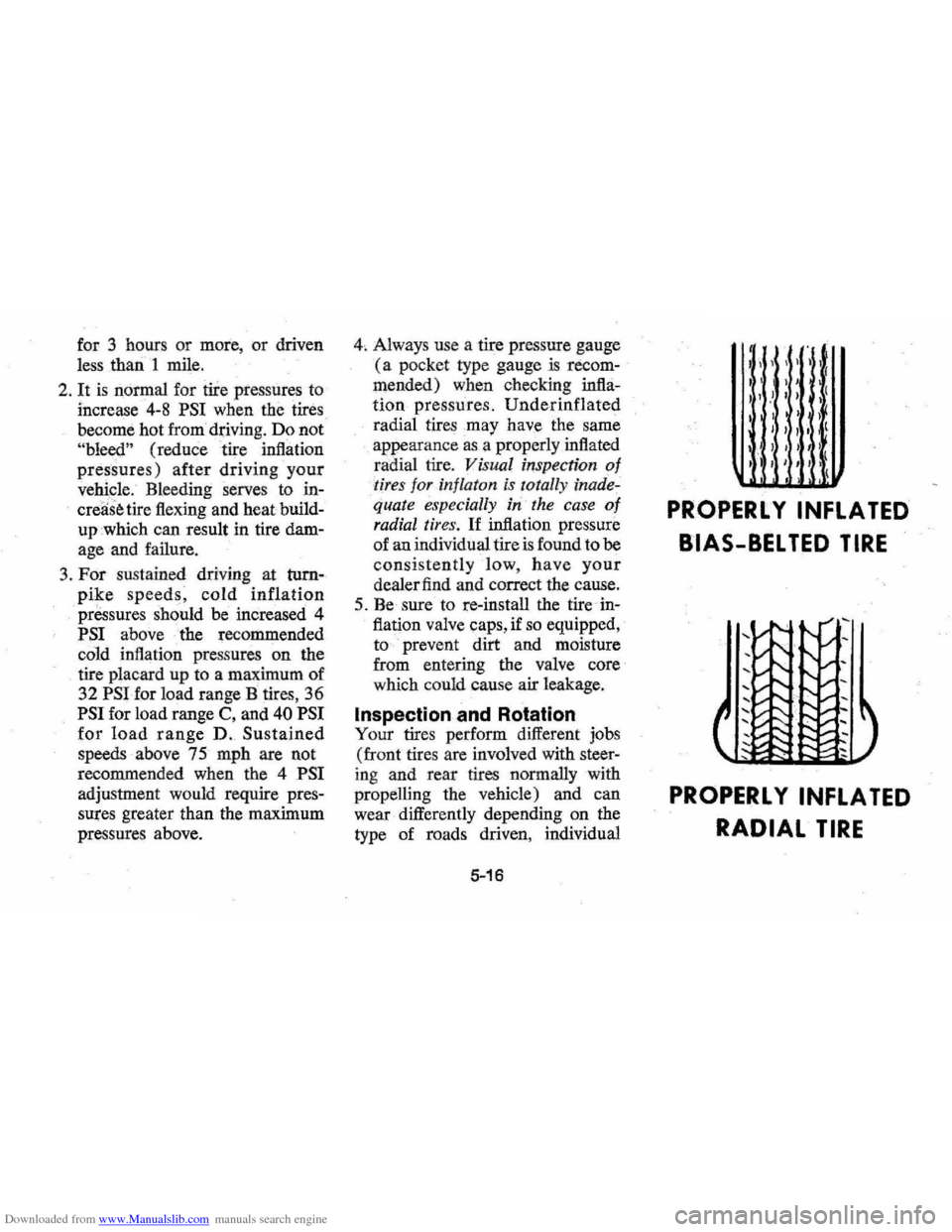
Downloaded from www.Manualslib.com manuals search engine for 3 hours or more, or driven
less than 1 mile.
2. It is normal for tiTe pressures to
increase 4-8 PSI when the tires
become hot from
driving. Do not
"bleed" (reduce tire inflation
pressures)
after driving your
vehicle. Bleeding serves
to in
crease tire flexing and heat build
up which can result in tire dam
age and failure.
3. For sustained driving
at turn
pike speeds; cold inflation
pressures should be increased 4
PSI above the recommended
cold inflation pressures on the
tire placard up
to a maximum of
32
PSI for load range B tires, 36
PSI for load range C, and 40 PSI
for load range D. Sustained
speeds above 75 mph are not
recommended when the 4
PSI
adjustment would require pres
sures greater than the maximum
pressures above.
4, Always use a tire pressure gauge
(a pocket type gauge is recom
mended) when checking infla
tion pressures. Underinflated
radial tires may have the same
appearance
as a properly inflated
radial tire.
Visual inspection of
-tires for in/laton is totally inade,
quate especially in the case 0/
radial tires. If inflation pressure
of an individual tire
is found to be
consistently low, have your
dealer find and correct the cause.
5. Be sure to re-install the tire in
flation valve caps, if
so equipped,
to prevent dirt and moisture
from entering the valve core
which could cause air leakage.
Inspection and Rotation
Your tires perform different jobs
(front tires are involved with steer
ing and rear tires normally with
propelling the vehicle) and can
wear differently depending on the
type of roads driven, individual
5-16
I
I '
,
)1, I
I I ( I , I , )' ,t
I ) I )
I , I I I I (
PROPERLY INFLATED
BIAS-BELTED TIRE
PROPERL Y INFLATED
RADIAL TIRE
Page 78 of 102
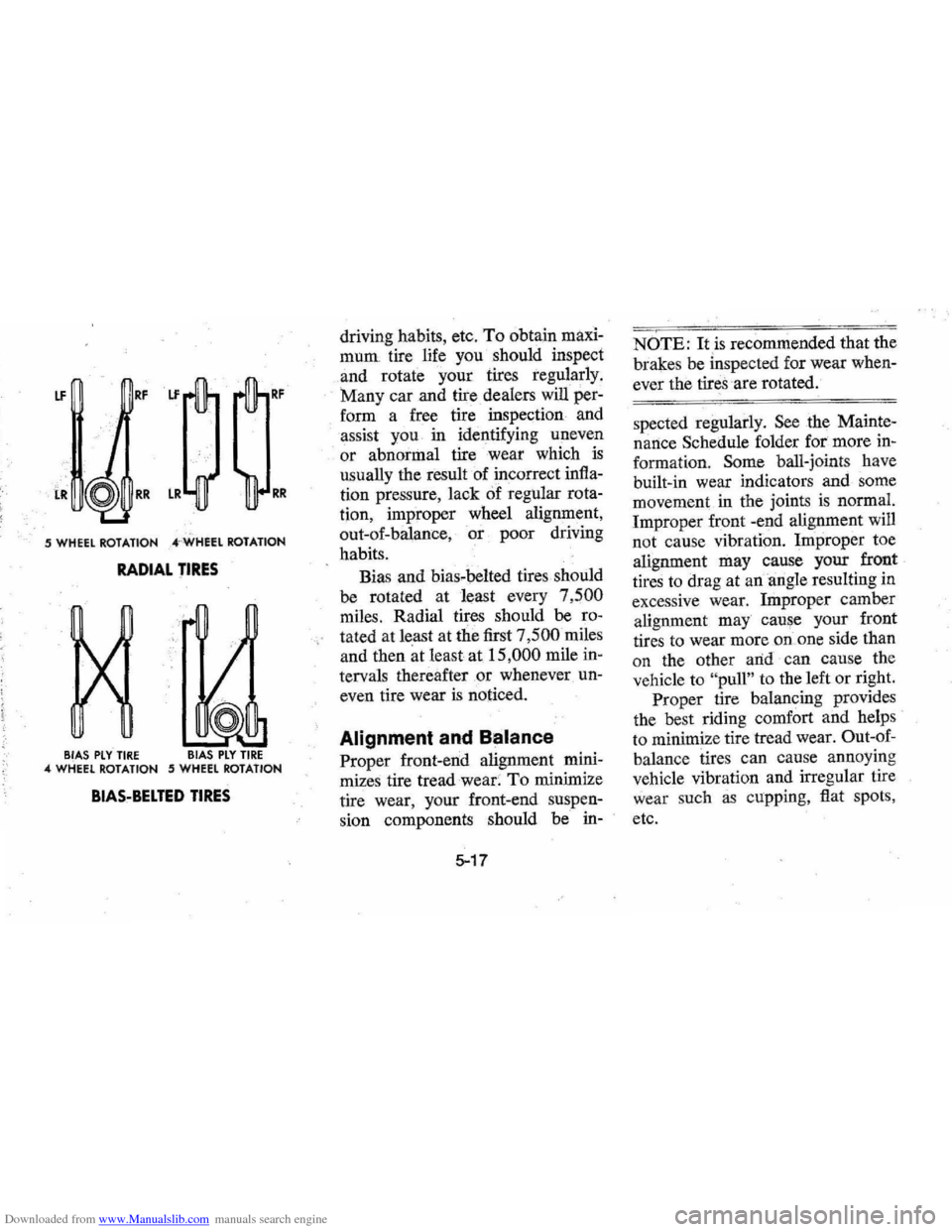
Downloaded from www.Manualslib.com manuals search engine LF RF LF
LR RR RR
.5 WHEEl ROTATION .. ··WHEEl ROTATION
RADIAL TIRES
BIAS PLY TIRE BIAS PLY TIRE .. WHEEl ROTATION .5 WHEEl ROTAtiON
BIAS-BELTED TIRES
driving habits, etc. To obtain maxi
mum. tire life you should inspect
a nd rotate your tires regularly.
Many car .and tire dealers will per
form a free tire inspection and
assist you in identifying uneven
or abnormal tire
wear which is
usually the result of incorrect infla
tion pressure , lack of regular rota
tion, improper wheel alignment,
out-of-balance ,
or poor driving
habits.
Bias and bias-belted tires should
be rotated
at least every 7,500
miles . Radial tires should be ro
tated at least at the first 7,500 miles
and then
at least at 15,000 mile in
tervals thereafter .or whenever. un
even tire wear is noticed.
Alignment and Balance
Proper front-end alignment ~i~i
mizes tire tread wear: To mlmmlze
tire wear, your front-end
susp~n
sion components should be m-
5-17
NOTE: It is recommended that the
brake s be
inspected for wear when
ever the tires are rotated.
spected regularly. See the
Main:e
nance Schedule folder for more lU
formation. Some ball-joints have
built-in wear indicators and some
movement in the joints
is normal.
Improper front -end alignment will
not cause vibration. Improper to e
alignment may cause your front.
tires to drag at an angle resulting in
excessive wear. Improper camber
alignment
may cause your front
tires to wear more on one side than
on the other arid can cau se the
vehicle to
"pull" to the left or right.
Proper tire balancing provides
the best riding comfort and helps
to minimiz e tire tread wear.
Out-of
balance tires can cause annoyin g
vehicle vibration and irregular tire
wear such
as cupping, flat spots,
etc.
Page 79 of 102
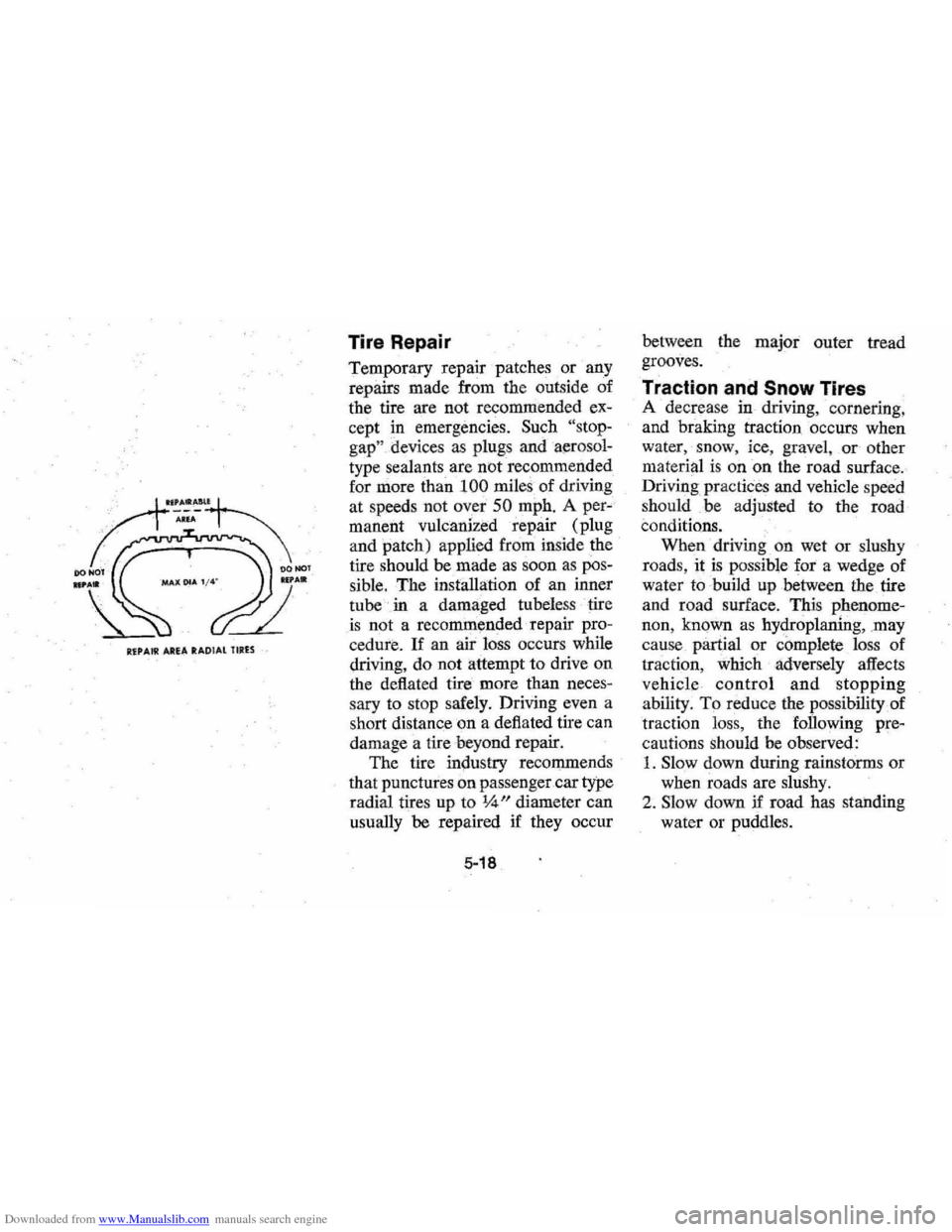
Downloaded from www.Manualslib.com manuals search engine Tire Repair
Temporary repair patches or any
repairs made from the outside of
the tire are not recommended ex
cept
in emergencies. Such "stop
gap" devices as plugs and aerosol
type sealants are not recommended
for more than
100 miles of driving
at speeds not over
50 mph. A per
manent
vulcanized repair (plug
and patch) applied from inside the
tire should be made
as soon as pos
sible. The installation of an inner
tube .
in a damaged tubeless tire
is not a recommended repair pro
cedure.
If an air loss occurs while
driving, do not attempt
to drive on
the deflated tire more than neces
sary to stop safely. Driving even a
short distance on a deflated tire can
damage a tire
-beyond repair.
The tire
in~ustry recommends
that punctures on passenger car type
radial tires up to
\4" diameter can
usually be repaired if they occur
5-18
between the major outer tread
grooves.
Traction and Snow Tires
A decrea se in driving, cornering,
and braking traction occurs when
water, snow , ice~ gravel, _ or other
material is on on the road surface.
Driving practices and vehicle speed
should be adjusted to the road
conditions.
When driving on wet or slushy
roads, it
is possible for a wedge of
water to build up between the tire
and road surface. This phenome
non, known
as hydroplaning, may
cause partial or complete loss of
traction, which adversely
affects
vehicle control and stopping
ability. To reduce the possibility of
traction loss, the
fan owing pre
cautions should be observed:
1. Slow down during rainstorms or
when roads are slushy.
2. Slow down if road has standing
water or puddles.